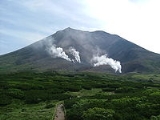
Asahidake
Encyclopedia
is the tallest mountain in Hokkaidō
, Japan
. Part of the Daisetsuzan Volcanic Group
of the Ishikari Mountains
, it is located in the northern part of the Daisetsuzan National Park
.
The mountain is popular with hikers in the summer and can be easily reached from Asahidake Onsen
via Asahidake Ropeway
.
Sugatami Pond, directly below the peak, is famous for its reflection of the peaks, snow, and steam escaping from the volcanic vents.
that arose 3 kilometres (1.9 mi) southwest of the Ohachi-Daira caldera. The Japan Meteorological Agency
gave the region rank C in volcanic activity. In addition to the main peak, there is a smaller volcano emerging from the southeast shoulder of the mountain, . It is a stratovolcano 2216 metres (7,270.3 ft) in height. The volcano consists mainly of andesite
and dacite
. That is Holocene
volcanic non-alkali mafic
rock less than 18,000 years old.
Mount Asahi currently exhibits steam activity in the form of fumaroles.
Hokkaido
, formerly known as Ezo, Yezo, Yeso, or Yesso, is Japan's second largest island; it is also the largest and northernmost of Japan's 47 prefectural-level subdivisions. The Tsugaru Strait separates Hokkaido from Honshu, although the two islands are connected by the underwater railway Seikan Tunnel...
, Japan
Japan
Japan is an island nation in East Asia. Located in the Pacific Ocean, it lies to the east of the Sea of Japan, China, North Korea, South Korea and Russia, stretching from the Sea of Okhotsk in the north to the East China Sea and Taiwan in the south...
. Part of the Daisetsuzan Volcanic Group
Daisetsuzan Volcanic Group
The is a volcanic group of peaks arranged around the wide caldera in Hokkaidō, Japan. In the Ainu language it is known as Nutapukaushipe or Nutaku Kamushupe. These peaks are the highest in Hokkaidō...
of the Ishikari Mountains
Ishikari Mountains
The is a range of volcanic mountains in central Hokkaidō, Japan. The mountain range is made up from the Daisetsuzan Volcanic Group and the Tomuraushi Volcanic Group. The volcanoes are part of the Kurile arc of the Pacific ring of fire.-References:...
, it is located in the northern part of the Daisetsuzan National Park
Daisetsuzan National Park
, or Taisetsuzan is located in the mountainous center of the northern Japanese island of Hokkaidō. At 2267.64 square kilometers, Daisetsuzan is the largest national park in Japan....
.
The mountain is popular with hikers in the summer and can be easily reached from Asahidake Onsen
Asahidake Onsen
is a small village in the Taisetsuzan National Park, Hokkaidō, Japan.The village consists of a few hotels and a youth hostel. It a popular base for hikers in the national park, and for tourists using Asahidake Ropeway to climb Asahidake, Hokkaidō's highest peak. There is also a hot springs resort,...
via Asahidake Ropeway
Asahidake Ropeway
The is Japanese aerial lift line in Asahidake Onsen, Higashikawa, Hokkaidō, operated by . Refurbished in 2000, the line climbs Mount Asahidake of Daisetsuzan Mountains, the tallest mountain in Hokkaidō...
.
Sugatami Pond, directly below the peak, is famous for its reflection of the peaks, snow, and steam escaping from the volcanic vents.
Geology
Mount Asahi is an active stratovolcanoStratovolcano
A stratovolcano, also known as a composite volcano, is a tall, conical volcano built up by many layers of hardened lava, tephra, pumice, and volcanic ash. Unlike shield volcanoes, stratovolcanoes are characterized by a steep profile and periodic, explosive eruptions...
that arose 3 kilometres (1.9 mi) southwest of the Ohachi-Daira caldera. The Japan Meteorological Agency
Japan Meteorological Agency
The or JMA, is the Japanese government's weather service. Charged with gathering and reporting weather data and forecasts in Japan, it is a semi-autonomous part of the Ministry of Land, Infrastructure and Transport...
gave the region rank C in volcanic activity. In addition to the main peak, there is a smaller volcano emerging from the southeast shoulder of the mountain, . It is a stratovolcano 2216 metres (7,270.3 ft) in height. The volcano consists mainly of andesite
Andesite
Andesite is an extrusive igneous, volcanic rock, of intermediate composition, with aphanitic to porphyritic texture. In a general sense, it is the intermediate type between basalt and dacite. The mineral assemblage is typically dominated by plagioclase plus pyroxene and/or hornblende. Magnetite,...
and dacite
Dacite
Dacite is an igneous, volcanic rock. It has an aphanitic to porphyritic texture and is intermediate in composition between andesite and rhyolite. The relative proportions of feldspars and quartz in dacite, and in many other volcanic rocks, are illustrated in the QAPF diagram...
. That is Holocene
Holocene
The Holocene is a geological epoch which began at the end of the Pleistocene and continues to the present. The Holocene is part of the Quaternary period. Its name comes from the Greek words and , meaning "entirely recent"...
volcanic non-alkali mafic
Mafic
Mafic is an adjective describing a silicate mineral or rock that is rich in magnesium and iron; the term is a portmanteau of the words "magnesium" and "ferric". Most mafic minerals are dark in color and the relative density is greater than 3. Common rock-forming mafic minerals include olivine,...
rock less than 18,000 years old.
Eruptive history
There is no historical record of the eruptions of Mount Asahi. Tephrochronology and radiocarbon dating have determined the following events:- 3200 BC ± 75 years, Asahi Soria deposit, corrected radiocarbon dating, explosive eruption
- 2800 BC ± 100 years, As-A tephra, corrected radiocarbon dating,explosive eruption and phreatic explosions
- 1450 BC ± 50 years, As-B tephra, uncorrected radiocarbon dating, explosive eruption and phreatic explosions
- 500 BC ± 50 years, Ash-b tephra, tephrochonology, explosive eruption and phreatic explosions and debris avalanches
- 1739, tephrochronology, explosive eruption and phreatic explosions with possible eruption of the central vent and radial fissures
Mount Asahi currently exhibits steam activity in the form of fumaroles.

